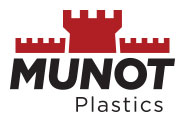When it comes to packaging your product, there’s no shortage of options to consider. Two of the most commonly used styles are clamshell and blister packaging—each offering unique advantages depending on the product and its intended use.
To help you make an informed choice, here’s a breakdown of clamshell and blister packaging, their key benefits, and how to determine which option is the best fit for your needs.
What Is Clamshell Packaging?
Clamshell packaging is a durable plastic container that folds over on itself using a built-in hinge, enclosing the product much like a clam shell. Typically made from polyethylene terephthalate (PET) or oriented polystyrene (OPS), clamshells are often transparent. These packages are ideal for high-value items like headphones, toys, food, or dental floss, where damage prevention, tamper resistance, and branding are top priorities.
Through thermoforming, manufacturers mold the packaging to match the product's shape. This design not only improves marketing efforts by putting the product front and center, but it also streamlines transport and inventory.
What Is Blister Packaging?
Blister packaging, on the other hand, uses a plastic cavity sealed onto a paperboard, foil, or paper backing. This form of packaging is especially popular for items like capsules, cosmetics, and medication. Created via thermoforming, blister packs are lightweight and compact, yet highly effective at protecting products from moisture, contamination, and tampering.
Thanks to their precise mold fit, blister packs work well for small, single-use items that require hygienic storage and easy access. They're also a great alternative to bulkier solutions like a corrugated fiberboard box or bubble wrap, making them ideal for contract packaging and efficient manufacturing.
Benefits of Clamshell Packaging
- Offers robust protection through rigid plastic, ideal for reducing product damage during transport.
- Enhances in-store merchandising with crystal-clear visibility and space for branding assets like an embedded logo.
- Includes resealable clamshell designs that improve usability for the consumer, adding convenience and minimizing waste.
Advantages of Blister Packaging
- Secures products with tight heat seals and molded cavities, perfect for tamper-resistant packaging.
- Works well for small items across industries, cutting down on materials and improving sustainable packaging metrics.
- Reduces reliance on bulkier options like corrugated box designs, boosting biodegradation and recycling capabilities.
Clamshell vs Blister Packaging: Which One Should You Choose?
Choosing between clamshell and blister packaging often depends on your product type, target customer, and sustainability strategy.
- For larger, high-visibility items like electronics, toys, or food packaging, a clamshell offers greater durability and shelf impact.
- If you're packaging medication, cosmetics, or smaller items, the compact and hygienic design of a blister pack might be a better fit.
- Evaluate your needs based on design, shape, material preferences, and the intended retail environment.
For Advanced Clamshell and Blister Packaging Solutions, Turn to Munot Plastics
No matter which style of packaging you prefer, you can trust Munot Plastics with your designing and manufacturing needs. We specialize in custom designs, thermoform tooling, and more to provide customers across all industries with the best packaging solutions. Reach out today to learn more and speak with our team.


